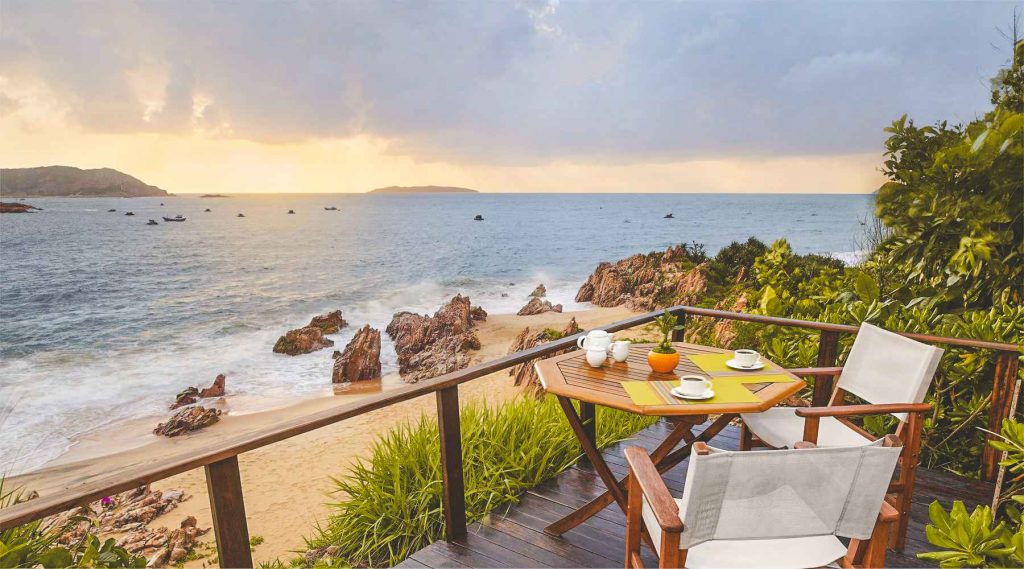What is Bai Xep Beach?
Setting & vibe

Bai Xep Beach lies about 10–13 km south of Quy Nhon, tucked between small hills with red rock outcrops at either end. The cove is sandy but compact, with basket boats pulled up along the shore and fishing nets drying in the lanes behind. At its heart, Bai Xep is still a fishing village, with narrow alleys, modest homes, and a few local seafood spots. Tourism arrived later, so the beach feels part-local, part-traveler hangout, with a relaxed and slightly rustic vibe.
How it developed
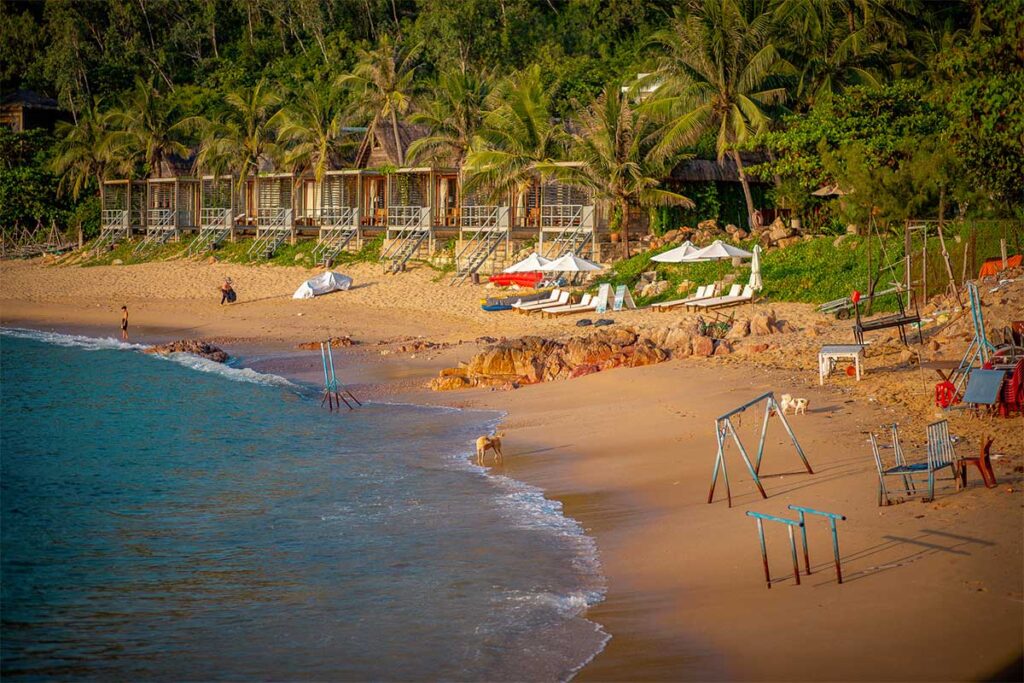
A decade ago, Bai Xep was almost unknown outside the region, with just a single hostel on the beach. Word of mouth spread, bringing more homestays and guesthouses, and eventually larger resorts further along the coast. The village itself remains small and walkable, but the mix of local life and tourism is more visible now. You can still watch fishermen mend boats and nets, but at the same time you’ll notice guesthouses, backpacker cafes, and restaurants catering to visitors.
What to expect (the honest picture)
Bai Xep is scenic and peaceful, with calm mornings and beautiful sunrises, but it is not a polished beach destination. Facilities are basic: limited shade, no sunbeds, and services depend on the small-scale businesses here. Cleanliness is inconsistent—parts of the beach can be spotless, others affected by litter or tide-borne trash. In the evenings, beach barbecues and karaoke sometimes add atmosphere for some and frustration for others. Eating seafood can be a highlight, but prices and portions vary, so clarity is important.
Things to do at Bai Xep Beach
Bai Xep is a simple place, and that’s part of its appeal. Days here revolve around the sea, fresh seafood, and slow village life. Don’t expect a long list of attractions; instead, it’s about enjoying the basics — swimming, walking the lanes, eating on the beach — and using Bai Xep as a base to explore the surrounding coastline.
1. Relax & swim
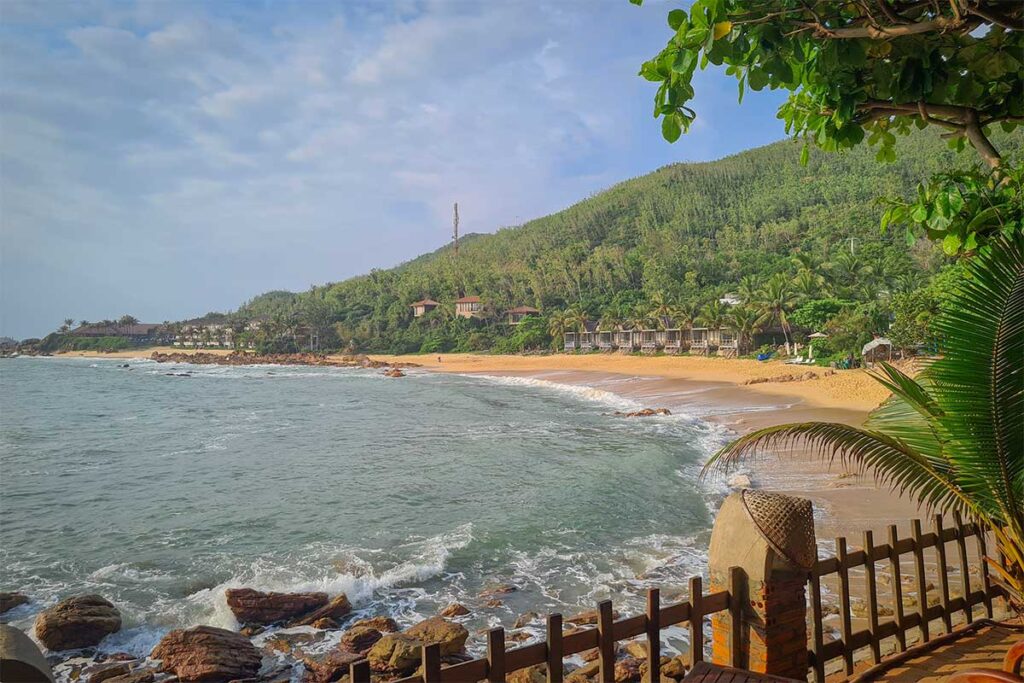
The sandy part of the cove is at its best near the southern end, where the beach is wider and the entry into the water is gentler. Swimming is pleasant on calm days, but waves can be stronger from September to November, and there’s no lifeguard. Shade is limited — a few trees and some seating from cafés or guesthouses — so bring a hat or plan to take breaks indoors.
2. Explore the fishing village

The village behind the beach is small and walkable in just a few minutes, but it gives a glimpse of everyday life. You’ll see basket boats pulled up on the sand, wooden boats being repaired, and fishing nets drying in the sun.
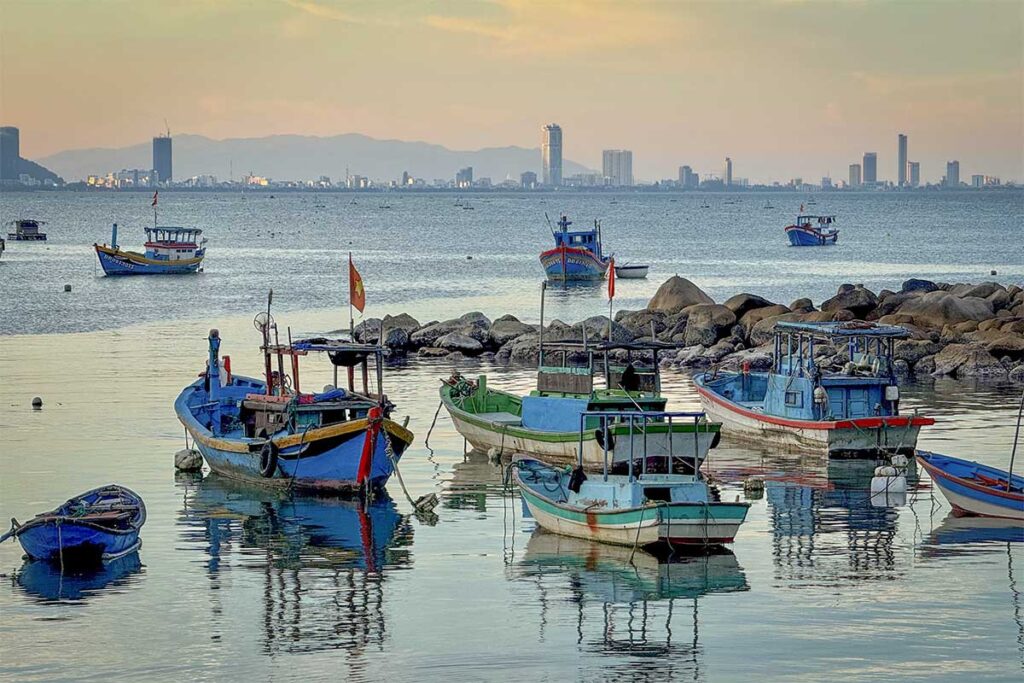
On the northern side, locals prepare their boats for the evening catch. The lanes are narrow, with chickens, children, and motorbikes weaving through, so walk respectfully. Always ask before taking close-up photos of people at work.
3. Snorkel or boat to nearby islets
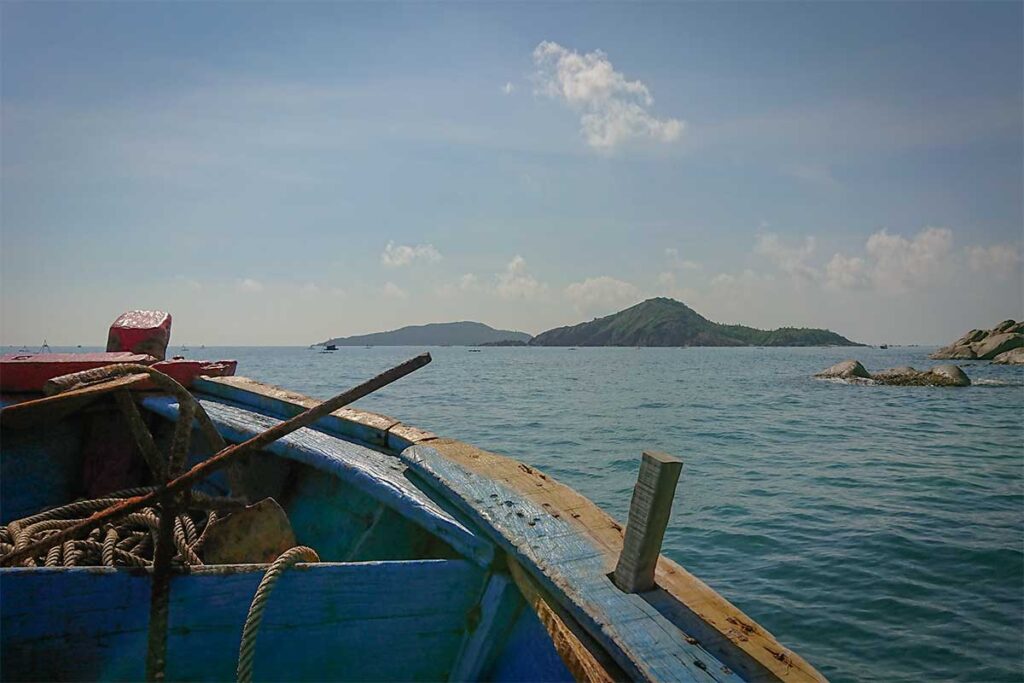
From the beach, you can arrange a short boat trip to small islands such as Hon Ngang. Expect a simple wooden boat with a local fisherman as captain. A round trip is usually priced per boat, with the captain waiting while you swim or explore — prices in the past were around 80,000 VND, but expect a bit more today.
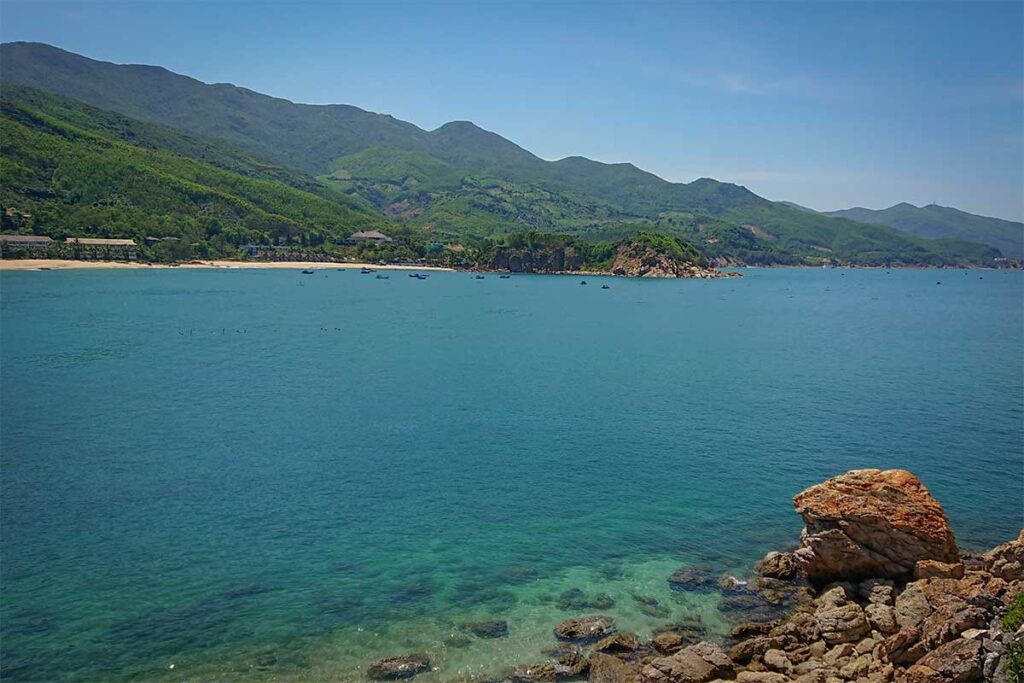

On these islets, there are rocky viewpoints, small stretches of sand, and tidal rock pools. Visibility is variable: you may see coral and fish in clear conditions, but don’t expect world-class snorkeling. Bring or rent basic gear, and wear sandals or reef shoes since rocks can be sharp.
4. Kayaking & SUP
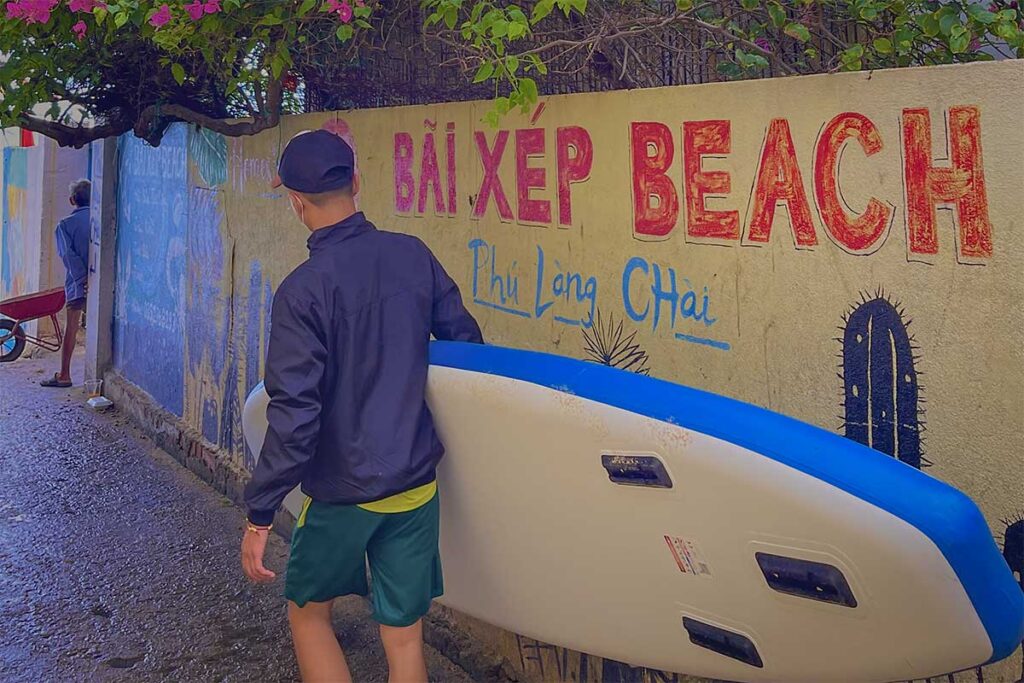
Kayaks and stand-up paddleboards are available for rent in the village, often through guesthouses. Prices can be unclear: some advertise per hour, others per half-day or day, and misunderstandings have caused disputes. To avoid surprises, confirm the duration and cost before paying. Calm mornings are the best time to paddle, when the water is glassy and you can head south along the cove or out toward the small islands. In the afternoon, winds often pick up.
5. Sunset & sunrise spots

Sunrise is a highlight here, with the sun rising directly over the sea. Early risers will often have the beach to themselves, aside from fishermen bringing in their catch. For sunsets, the hills and rocky points at both ends of the cove make good spots, especially the small path over the northern bluff. Bring a tripod if you’re serious about photography, or just enjoy the view with your phone and a drink.
6. Seafood on the sand
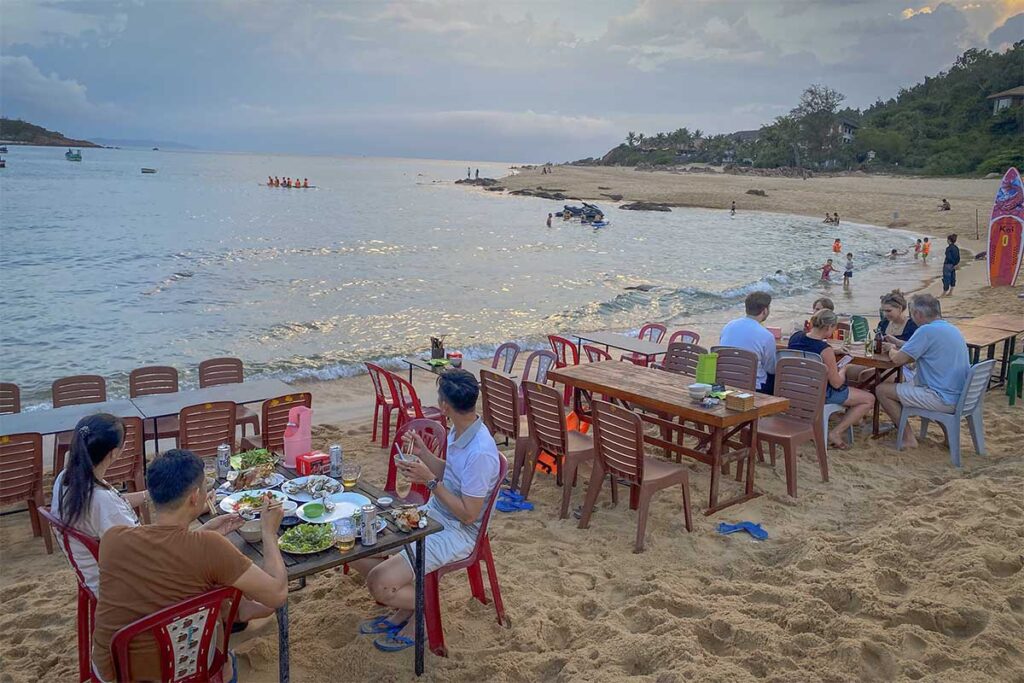
In the evenings, locals set up simple plastic tables and bright lights right on the beach, serving whatever was caught that day. It’s not a romantic setting, but the seafood is fresh — expect clams, squid, crab, or lobster.

To avoid misunderstandings, agree on the price and whether sides are included before ordering. Another option is to eat at guesthouse restaurants like Big Tree or Haven, where the food is slightly more expensive but service is clearer.
7. Coastal drive & beach-hopping

One of the best things about Bai Xep is its position on the coastal road south toward Phu Yen. This route is stunning, with cliffs, headlands, and little bays such as Bai Bau, Bai Rang, and Bai Bang. Some are completely undeveloped, making them feel wild and remote. The ride itself is worth it, but you’ll need a motorbike or a car with driver. Renting a motorbike is easiest in Quy Nhon city; in Bai Xep, availability is patchy and usually only through local guesthouses.
8. Easy day trips from Bai Xep
While Bai Xep itself is small, it makes a decent base for exploring. To the north of Quy Nhon (about 40 minutes by car or bike) are Ky Co Beach and Eo Gio, known for their dramatic cliffs and turquoise water, plus the Phuong Mai Sand Dunes. In Quy Nhon city (25–40 minutes away) you can visit the Cham Twin Towers or the larger Banh It Towers further inland. For snorkeling and fishing village life, Hon Kho Island lies about 40 minutes north of Bai Xep. These aren’t right next door, but all are doable in a day trip if you’re happy to ride or arrange a driver.
Best time to visit Bai Xep Beach
Because Bai Xep is mainly about beach time, the season makes a big difference. The dry season from February to August is the most comfortable, with calmer seas and sunny days — best for swimming, snorkeling, and relaxing on the sand. From September to November, waves are often stronger and rain more frequent, which can make the beach less inviting. December and January bring cooler, breezier weather, better for coastal walks than for swimming.
Crowds are rarely heavy, but do expect more visitors on weekends and public holidays, when locals come for seafood dinners on the sand. For a quieter experience, early mornings are the most peaceful times to be on the beach.
Where to stay in and around Bai Xep
Accommodation around Bai Xep ranges from simple village guesthouses to comfortable resorts tucked along the same bay. Staying here gives you direct beach access and a quieter atmosphere than Quy Nhon city, but facilities are limited and nights can sometimes be noisy with karaoke on the sand. If you prefer more choice in dining, cafés, and transport, staying in Quy Nhon and visiting Bai Xep as a day trip might be the easier option.
Haven Vietnam (with Big Tree) – in-village, on the beach
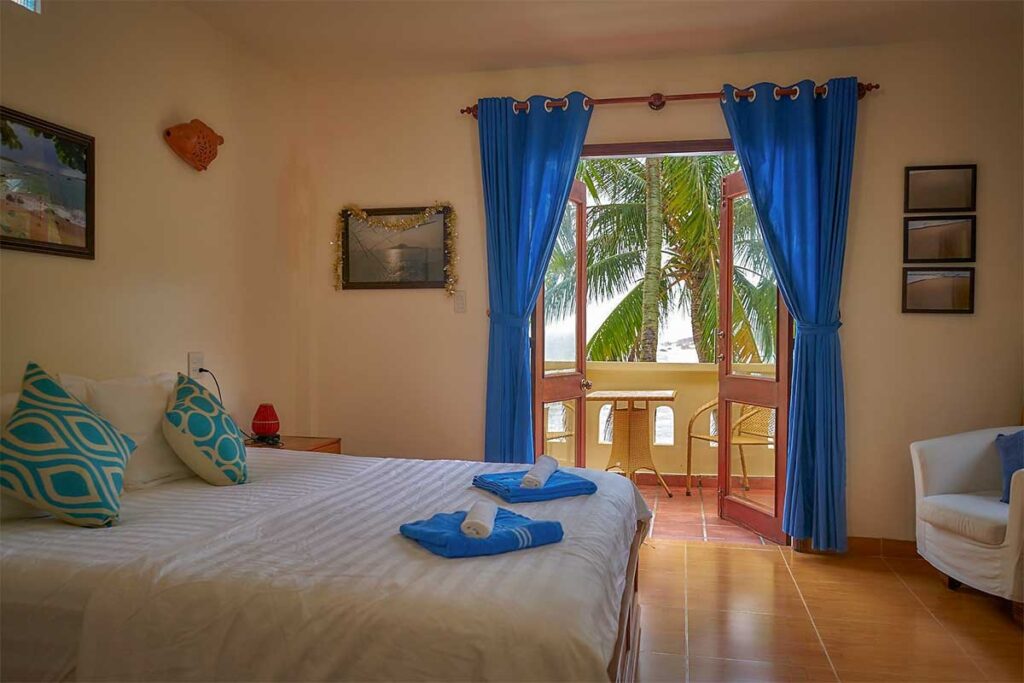
Haven is the most established option within Bai Xep itself, set right on the beach with sea-view rooms above the Big Tree restaurant. It’s a good fit for couples or anyone wanting to stay in the middle of village life while still having a bit of comfort. The restaurant has a varied menu, including vegetarian dishes, and overlooks the cove. Rooms are spacious and well-kept, though sound carries easily — in the evenings you may hear local karaoke or seafood dinners happening just outside. The accommodation also helps arrange island-hopping trips.
Avani Quy Nhon Resort – along the same bay (not in the village core)
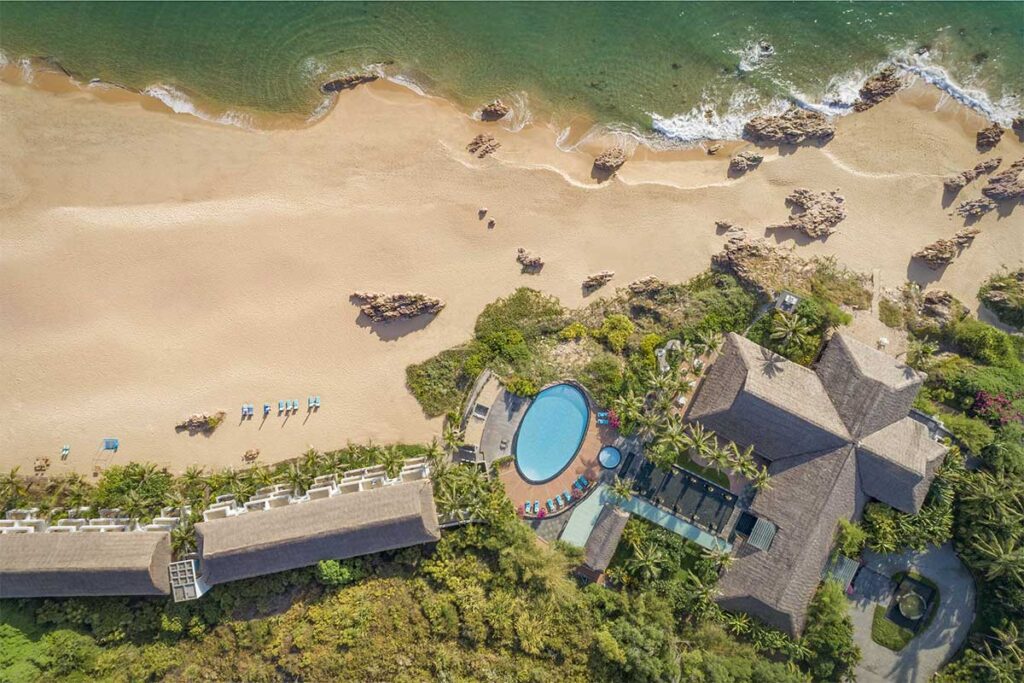
Avani occupies a quieter stretch of beach a short distance from Bai Xep village. The resort has its own pool, spa, and kids’ club, making it better suited for families or travelers who want hotel-style facilities rather than village simplicity. The beach in front of Avani is particularly clean, with calm clear water for swimming. Rooms and common spaces are comfortable, though some parts of the property are starting to show age. Guests also share access to the larger spa and fitness facilities of the neighboring Anantara resort.
Life’s a Beach – now further south in Phu Yen
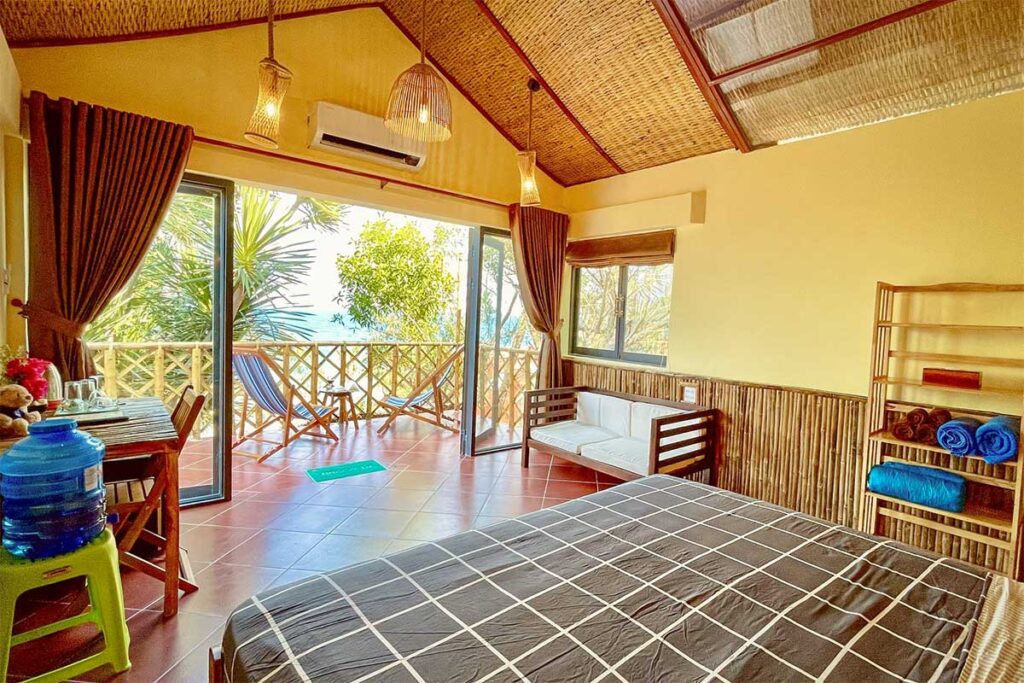
Life’s a Beach was the first backpacker hostel to put Bai Xep on the map, but it has since relocated just over the provincial border into Phu Yen. It remains popular for its social atmosphere, communal family dinners, and mix of dorms, simple rooms, and glamping tents right by the sand. For travelers who want a lively, international vibe and don’t mind being outside the village itself, it’s still worth considering. Just keep in mind it’s no longer part of Bai Xep proper, so it suits those prioritizing hostel culture over direct access to the fishing village.
Other options
Behind the beachfront, you’ll find a handful of smaller homestays and guesthouses. These are basic but affordable, usually run by local families. Rooms can be simple, so check if they have proper ventilation or air conditioning, and expect some village noise at night. Payments are often cash only, and English may be limited, but for travelers who value immersion over comfort, these stays can be rewarding.
Practical visiting information & tips
Bai Xep is still a small village rather than a polished resort town, so it helps to come prepared. A few simple tips can make your stay more comfortable and avoid common frustrations.
Money, shops & ATMs
There is no ATM in Bai Xep, so bring enough cash in smaller bills for meals, boat trips, and small purchases. Resorts and some guesthouses accept cards, but most local seafood spots and homestays are cash only. Small mini-shops in the lanes sell drinks, snacks, and basic toiletries, but don’t expect much variety.
Beach basics
Shade is limited and there are no sunbeds for rent. Bring a hat, sunscreen, and drinking water if you plan to spend time on the sand. The beach has some rocky sections and sea urchins can be present, so reef shoes or sandals are useful.
Seafood & price etiquette
Seafood dinners on the beach can be a highlight, but pricing is not always transparent. Agree on the price per kilo, ask how it will be cooked, and confirm if side dishes are included. Drinks are sometimes forgotten or added later, so check before ordering. Knowing a few simple phrases like “bao nhiêu tiền?” (how much?) can help.
Cleanliness & etiquette
Litter is an ongoing issue. Try to carry out what you bring in, and avoid adding to the problem. Litter can be an issue after evening BBQs, though resorts and villagers usually clean up by the next morning. Bring a bag to carry your own waste out, and avoid leaving anything behind on the sand.
Noise & expectations
Evenings can be lively with karaoke and BBQs on the sand. Rooms directly on the beachfront are more exposed to this, while those a little higher up in the village are quieter. Earplugs are a good idea if you are sensitive to noise.
Safety & swimming
The sea is calm in the dry season but can have stronger waves from September to November. Always check conditions before swimming, especially with children. Be careful around the rocky ends of the cove, and don’t leave valuables unattended on the beach. Village lanes have limited lighting at night, so bring a torch or use your phone flashlight.
Respecting village life
This is still a working fishing community. Keep clothing modest when walking through the lanes, especially near homes or temples. Ask before taking photos of people or their work. Expect animals — dogs, chickens, and motorbikes — to share the narrow lanes with you, so walk with awareness.
Is Bai Xep worth visiting?
Bai Xep will appeal to travelers who enjoy small, low-key places where daily life is still tied to fishing and the sea. The cove itself is pretty, sunrises are memorable, and it’s easy to spend a few quiet days swimming, eating fresh seafood, or exploring the coastal road. If you’re looking for a relaxed stop with simple guesthouses, a touch of village charm, and no big crowds, this beach delivers.
On the other hand, Bai Xep is not for everyone. Facilities are basic, cleanliness is inconsistent, and evenings can be noisy with karaoke on the sand. If you prefer polished resorts, wide beaches with sunbeds, or more reliable dining and shopping, you may find Quy Nhon city beach or day trips to Ky Co and resort beaches more rewarding.
